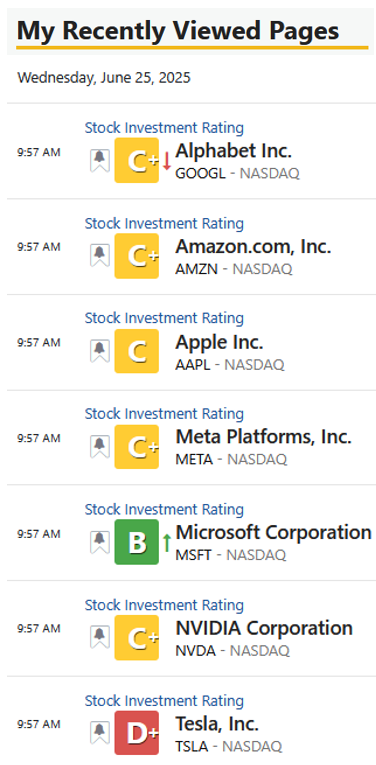Two Mag-7s Earned a New ‘Buy’ Rating in June. But Only One KEPT It!
Welcome to your June State of the Ratings.
This is your monthly guide to what’s new in the Weiss Ratings universe …
Stocks newly upgraded to “Buy” and downgraded to “Sell” …
And features we’ve just released to help you get the most out of your membership.
You can read your premier issue here. For your convenience, you can find all your issues under the Research tab.
And to see how Weiss Ratings Plus gives you a data-based edge this month, read on.
What’s New in the Weiss Ratings:
No Mag-7s Were Buys in June … Until This Upgrade
The Magnificent 7 don’t grab headlines like they used to.
That’s because the market-leading stocks of the past few years now underperform the bottom 98.6% of the S&P 500.
That’s collectively. Individually, it’s a different story.
It’s also a story you won’t find anywhere else.
That’s because two of these tech titans — Microsoft (MSFT), and Alphabet (GOOGL) — just got their Weiss “Buy” ratings restored.
In MSFT’s case, it enjoyed two upgrades this month!
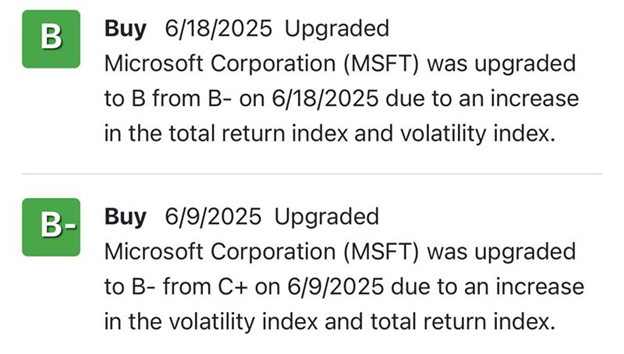
Microsoft’s upgrade happened because of increases in the stock’s total returns. Those returns were bolstered by strong growth in their earnings and cash flow.
I was just about to say the same about Google. But right before I hit the “publish” button on this issue, it dropped back into “Hold” territory.
We’ll look closer at why in just a moment. Along with some other proprietary metrics you won’t find anywhere else.
For starters …
Only members of Weiss Ratings Plus can see the upgrade and downgrade history of every asset we rate.
Today, you’ll see how you can use this unique data to find and track trends like this one.
That brings me to another set of seven …
Why Are the Mag-7 Ratings Changing?
It’s the same reason why any of our 53,000+ rated assets might see an upgrade or downgrade.
The Weiss Rating System monitors and detects specific data and metrics.
Understanding these can help you find trends like the one we’re exploring today.
7 Drivers Our System Considers
The Weiss investment ratings are based on the balance of the Reward and Risk ratings.
These two pillars are underpinned by several key metrics and factors.
Those include total return, growth, solvency, efficiency, dividends, volatility and valuation.
- Total Return: stock price performance plus dividend payouts
- Growth: net income, EPS, operating profit and cash flow
- Efficiency: return on shareholder equity (ROE), assets (ROA) and total capital (ROIC)
- Solvency: debt levels, liquidity, debt-to-equity (D/E)
- Volatility: stock price beta and standard deviation
- Dividends: dividend safety, yield, growth, and consistency
- Valuation: price-to-earnings (P/E), price-to-book (P/B), price-to-sales (P/S)
Changes in any of these metrics can impact a stock’s rating.
Now, let’s look at how you can explore, track and analyze this information.
And, of course, how you can use it to your advantage.
3 Tools to Track Mags & Lags
You learned in your Quick-Start Guide how to set up alerts for stocks you want to follow.
Just click on the white flag to the left of their name. When it turns green, you’re all set to get notified when their ratings change!
And in your May State of the Ratings issue, you saw how to set up a price alert. It’s a quick way to set a “mental” stop or target without placing an order with your broker.
But suppose you didn’t set an alert and want to revisit some stocks you looked up recently.
No problem! You can revisit your Weiss Ratings Plus browsing history at any time.
Just click on Recently Viewed. You’ll see a full list of articles, stock tickers and other assets you’ve visited.
Then, from any asset’s page, you can use two very powerful tools: Rating History and Comparison.
Those are designed to help you conduct your own head-to-head analysis on assets you want to own.
They go above and beyond the current grades to show you …
How to Use Rating Changes in Your Investing
To be clear, a new “Buy” rating may be reason enough to add a stock to your portfolio.
After all, every stock rated "Buy" by Weiss Ratings has delivered an average return of 303%.
That’s even including all the losers — over the past 22 years.
But we always want our members to do their own due diligence.
That’s because, as things change for them, good or bad, so do their ratings.
What the Ratings Can Tell You About the Mag-7
Most people probably assume the market’s most-talked-about stocks are Weiss “Buys.”
But this year saw a decline in tech stock prices across the board. And some of the ratings followed.
The market bounced back. But among the Mag-7, only Microsoft and Alphabet saw their ratings recover.
In fact, just before MSFT’s and GOOGL’s June upgrades, none of the Mag-7 were buys.

Going back a bit further, four of the Mag 7 held a “Buy” rating for almost all of 2024. The other three have had a current “Hold” or “Sell” Weiss rating for at least the past 30 days.
Total Return and Volatility stood out as drivers of the tech upgrade and downgrade trend.
Below you can see Microsoft’s factors earn high marks.
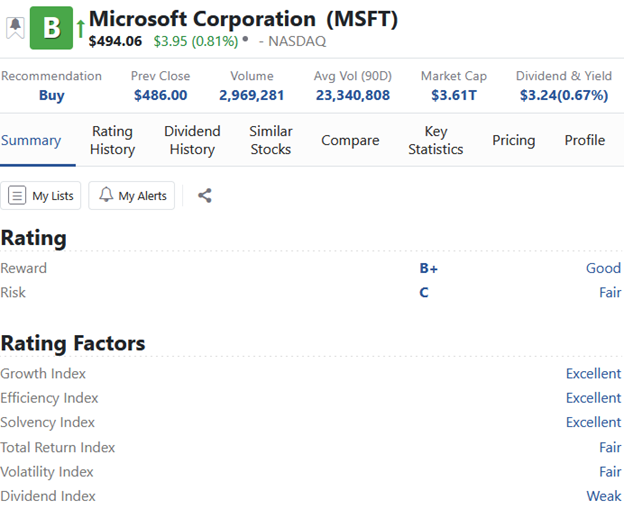
Now compare that to the biggest Mag-7 laggards:
- Apple (AAPL) took a hit in Growth, Valuation and Solvency as tariff-war reactions impacted its earnings.
- And Tesla (TSLA) saw its rating step into “Sell” territory due to weakness across every factor.
Apple and Tesla both saw their stocks give up about 20% in 2025.
Still, the Mag-7 as a group represents about 34% of the S&P 500’s total value.
Together, their stocks are flat for this year. Meanwhile, the other 493 are up 6%.
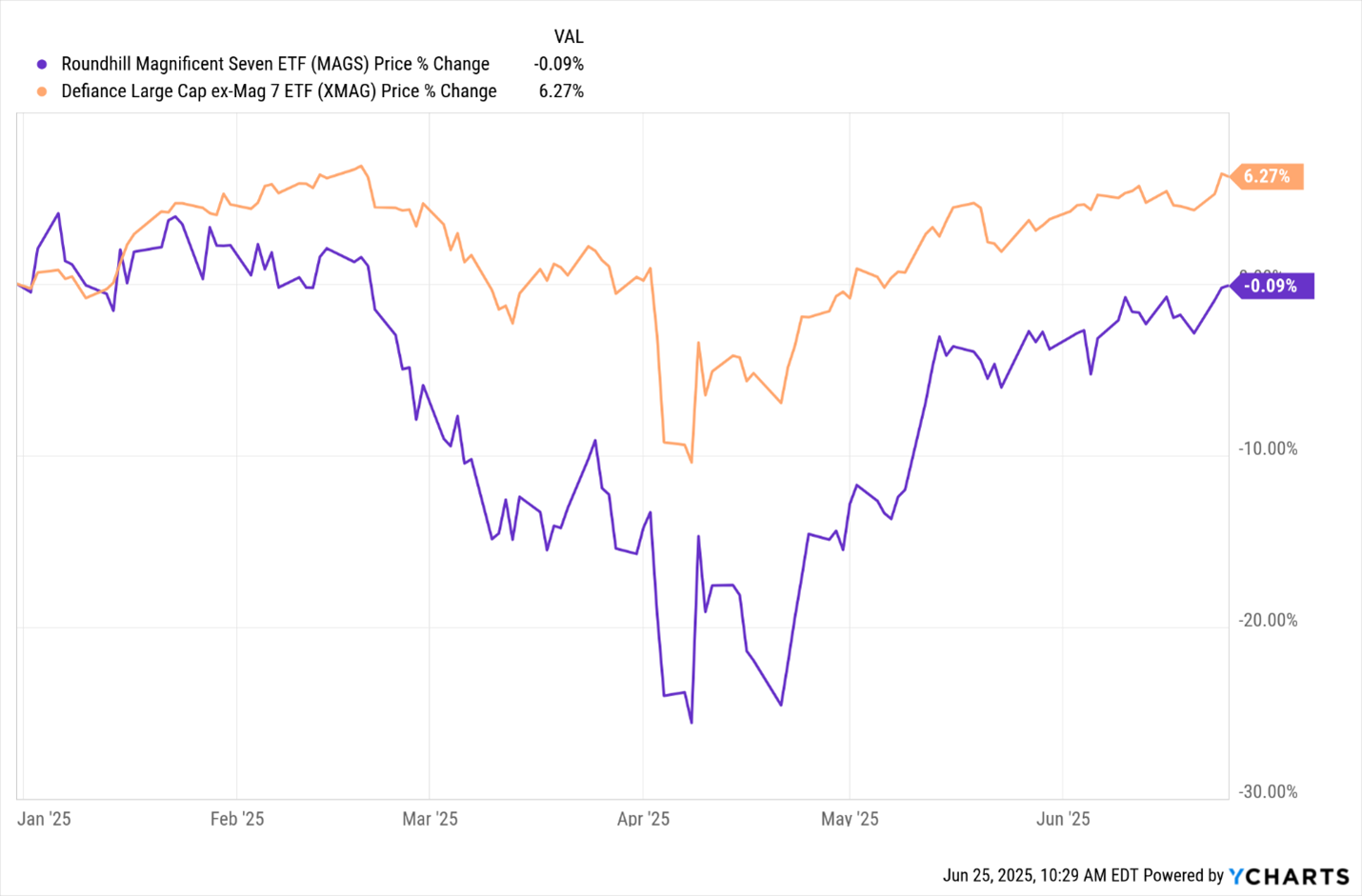
The rest of the market is closing the gap when it comes to earnings growth performance.
In fact, the average growth rate of the lower 493 is expected to surpass the Mag-7s by 2026.
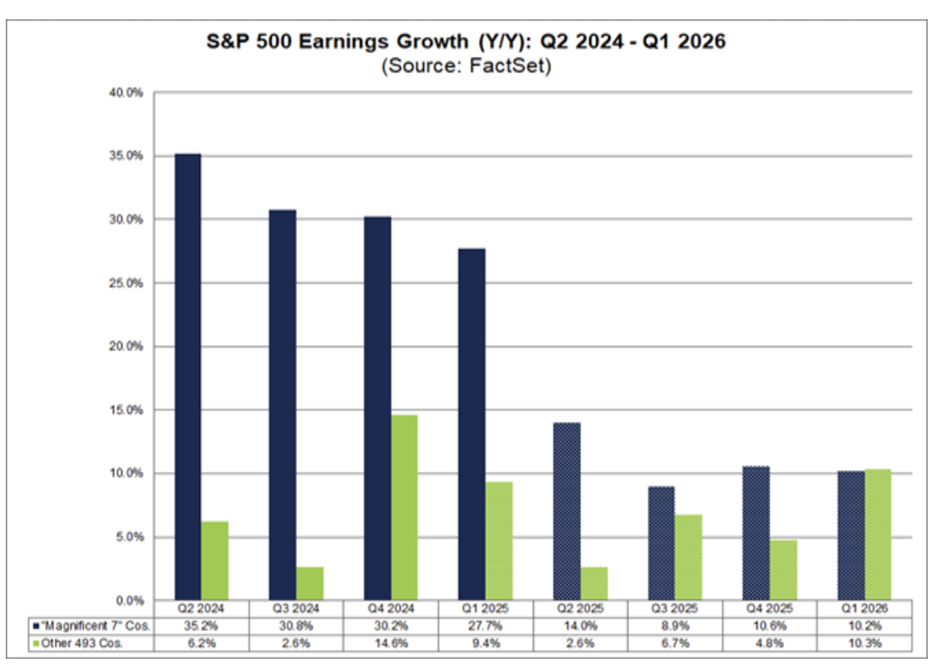
But don’t count out the Mag-7. Especially not our lone “Buy”-rated one, Microsoft.
After all, there would be no stock upgrades if companies weren’t doing something — or several somethings — right.
Why Microsoft Made the Grade
When a stock’s investment rating is upgraded or downgraded, you’ll notice an up or down arrow next to the ticker.
Microsoft was upgraded to a “B-” on June 9 and a “B” on June 18.
You know it’s a recent upgrade thanks to that up arrow.

If you want the full story about when or why Microsoft or any stock’s rating changed, that’s available exclusively to you as a Weiss Ratings Plus Member.
If you click on Microsoft’s Rating History tab, you can see it had a “Buy” rating for over two consecutive years until it was downgraded to a “Hold” on April 15.
Then on May 2, Microsoft went from a “C+” to a “B-” thanks to a massive surge in cash flow and EPS and lower debt-to-equity ratio.
This positive data led to increases in our Growth, Volatility and Solvency indexes.
What’s intriguing here is the timing …
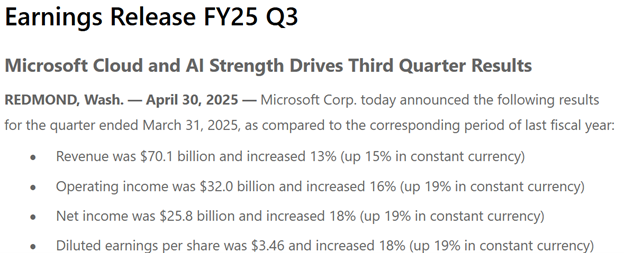
The rating change came shortly after Microsoft’s Q1 earnings data, released April 30, was absorbed by the Weiss system.
There was a short-lived downgrade, however.
That happened on May 19. Microsoft became a “Hold” due to declines in Valuation, Volatility and its Dividend Index.

These types of index changes are not unusual. In fact, they can be consistent with a surging stock.
In the 30 days running up to the rating change, Microsoft’s stock soared by over 20%.
However, volatility increased as the price surged and its dividend yield weakened — a classic sign of short-term overheating.
Once the stock price stabilized in June, it returned to “Buy” territory.
Alphabet Followed a Similar Pattern
On April 25, GOOGL’s rating increased on improvements in net income and total capital.

It fell briefly to “Hold” amid volatility.
Then it shifted back to “Buy” on June 4 as the stock price stabilized.
And it just flipped back to a “C+” thanks to a decline in its Total Return and Valuation.
What this shows us is that the Weiss Ratings are constantly updated.
So, it can pay to check your favorite stocks regularly.
Whenever there’s new data … be it earnings, earnings revisions, stock price action, new Form-10 and other filings, etc. … our system collects that data and re-computes it accordingly.
Remember, we have one of the largest financial datasets in the world. One with seven terabytes, with proprietary state-of-the-art technology analyzing this data 24/7.
Today, you’re really getting to see it in action!
If You Wanted to Invest Today …
You can use your Weiss Ratings tools to tell whether Microsoft is a buy for you.
The Compare tab lets you conduct a detailed head-to-head analysis of up to four stocks.
Other than their ratings, Microsoft and Google are equals across nearly every rating and factor grade.
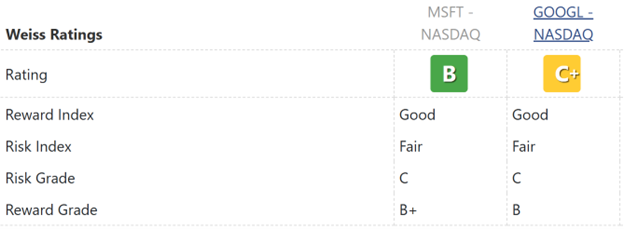
Both are excellent in Growth, Efficiency and Solvency.
They’re weak in Dividends.
And fair in Total Return and Volatility.

That said, Microsoft has outperformed GOOGL in price performance. And just look at the P/E ratios below. Microsoft is trading at 37.5x earnings and Alphabet at below 19x.

Generally, lower is better if you’re looking for a bargain.
But it is important to consider a stock’s metrics relative to its sector and industry.
Microsoft’s P/E ratio is in line with the S&P 500 tech sector median and Alphabet’s the communication sector median.
So one could argue that, based on P/E ratios, both stocks are fairly valued.
However, that argument collapses if you believe Alphabet is closer to being a tech stock than a communication stock.
Alphabet — in both absolute and relative terms — significantly outperforms Microsoft in EPS growth (37.5% vs. 12%).
Either way, both have strong fundamentals. And the Weiss rating appears to be the tiebreaker in this comparison exercise.
Another Idea
Microsoft looks like a solid investment based on our ratings model.
But if you’re up for some more risk, our resident tech expert recently wrote about another Mag-7 that he finds worth a second look.
Amazon (AMZN) made what Michael A. Robinson, believes is a world-class acquisition. It bought a little-known company called Annapurna Labs for $400 million.
With this purchase, Amazon gains a stronger foothold in the AI Supercycle. And Michael believes this partnership could help AMZN step back into “Buy” territory from its current “C+” rating.
With the tools available to you on the Weiss Ratings Plus website that we discussed today, now you know how to:
- See Amazon’s Rating History.
- Compare its factors/drivers to other stocks, the sector or the industry as a whole.
- And, of course, set up alerts to let you know about any ratings or price changes.
And those are just a few of the features waiting for you on your members-only website.
In fact, we have two brand-new features for you this month.
This Month’s New Weiss Ratings Plus Release
The Weiss Ratings team is upgrading your Weiss Ratings Plus MasterClass videos.
We just uploaded two new videos to your Tutorial Videos tab.
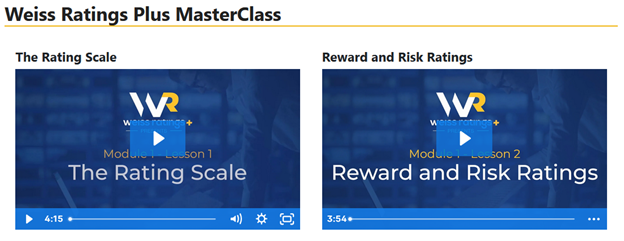
The first, The Rating Scale, gives you a quick (four-minute) overview of the Weiss Ratings letter grades.
You’ll see how they connect to actionable “Buy,” “Hold” and “Sell” recommendations. And we’ll show you an idea and potential outcomes for it.
And in the second, Reward and Risk Ratings, you’ll get a 30,000-foot view of one of the topics we covered together today.
This video shows you the significance of using Reward Ratings to evaluate potential returns and Risk Ratings to measure potential volatility and downside.
We plan to add more videos in the coming months.
And I’ll be sure to tell you about those here first.
To your success,
Dallas Brown
Publisher
P.S. Your favorite Weiss editors use these tools when they research new ideas. Sean Brodrick uses an additional tool, cycles research, to pinpoint exactly when to buy.
Sean just alerted me that not one, not two, but three cycles are converging all at once … right now. The last time this Triple Convergence happened was 1913.
The result? The U.S. raised its defense budget 4,000% in the next few years. Great Britain’s budget went up over 3,300% (to 35% of national GDP). And over $7.5B in today’s money was spent on machine guns alone.
If the War Cycle that’s ramping up right now holds true to its history, Sean says billions of dollars are set to flow into the latest, most advanced technology.
And in this brand-new video presentation, Sean reveals that five cutting-edge military stocks could carry the day.
Watch this informative video to the end to see how you can get the names and ticker today.

